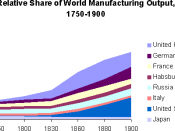The Industrial Revolution began the blueprint for the future development of public and private infrastructures, known as vertical or "top-down"� hierarchy. Traditionally, vertically integrated companies are focused upward toward the managing bureau chiefs. This makes for very inefficient and ineffective processes, because each bureau in effect is a separate business. For example, the quality department is in charge of the quality business. The Purchasing department is in the purchasing business and so on. All the departments within an organization operate on a different wavelength and at a different pace: walking down the hall with their horse blinders on. When the various bureaus attempt to come together to meet customer needs, the result is poor product and service quality. You can hear throughout the organization, "It's not my job."� This is where things slip through the organizational cracks. When customer service complaints go unnoticed, or employees get defensive about reporting quality deficiencies, or management does not pay sufficient attention to recognizing good or excellent performance by staff, the organization is vertically challenged.
Frank Ostroff writes, "Vertical organizations have been rendered inadequate for today's demanding competitive, technological, and workforce environments by its inherent shortcomings."� What does this mean to the organization? The focus is to drive greater simplification in the organization. The simpler organizations are and better aligned they are upstream and downstream, the more effective they will be in the execution of future business needs. By simplifying the messages and communications organizations will eliminate uncertainty. In addition, a simpler organization will allow for tasks to be completed once. In today's organizations, many businesses tend to do many things several times, resulting in increased costs and slower execution. But, breaking away from the traditional "vertical"� management processes toward cross-functional, integrated business processes has posed many new challenges, especially when it comes to...


